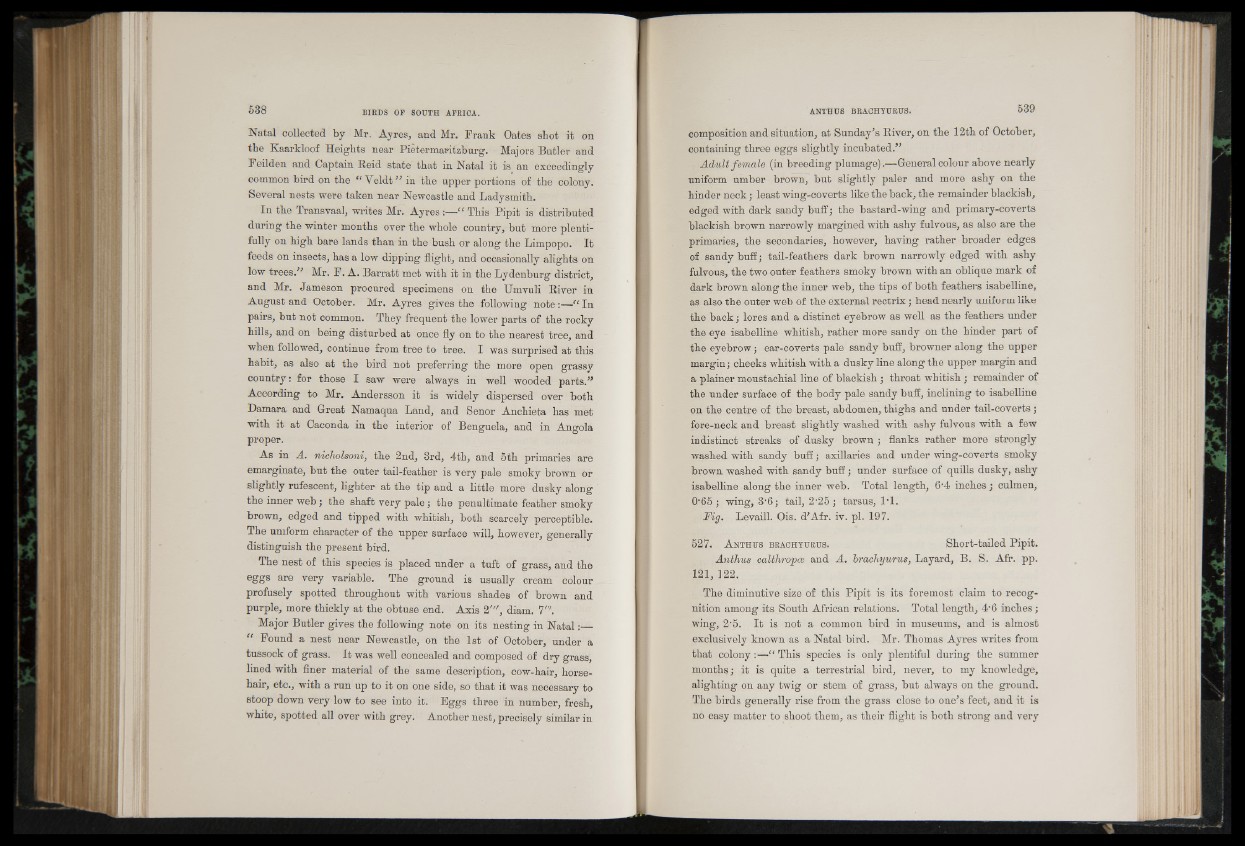
Natal collected by Mr. Ayres, and Mr. Prank Oates shot it on
the Kaarkloof Heights near Pietermaritzburg. Majors Butler and
Peilden and Captain Reid state that in Natal it is an exceedingly
common bird on the “ Veldt ” in the upper portions of the colony.
Several nests were taken near Newcastle and Ladysmith.
In the Transvaal, writes Mr. Ayres:—“ This Pipit is distributed
during the winter months over the whole country, but more plentifully
on high bare lands than in the bush or along the Limpopo. It
feeds on insects, has a low dipping flight, and occasionally alights on
low trees.” Mr. P . A. Barratt met with it in the Lydenburg district,
and Mr. Jameson procured specimens on the Umvuli River in
August and October. Mr. Ayres gives the following note:—“ In
pairs, but not common. They frequent the lower parts of the rocky
hills, and on being disturbed at once fly on to the nearest tree, and
when followed, continue from tree to tree. I was surprised at this
habit, as also at the bird not preferring the more open grassy
country: for those I saw were always in well wooded parts.”
According to Mr. Andersson it is widely dispersed over both
Damara and Great Namaqua Land, and Senor Anchieta has met
with it at Caconda in the interior of Benguela, and in Angola
proper.
As in A. nicholsoni, the 2nd, 3rd, 4th, and 5th primaries are
emarginate, but the outer tail-feather is very pale smoky brown or
slightly rufescent, lighter at the tip and a little more dusky along
the inner web; the shaft very pale; the penultimate feather smoky
brown, edged and tipped with whitish, both scarcely perceptible.
The uniform character of the upper surface will, however, generally
distinguish the present bird.
The nest of this species is placed under a tuft of grass, and the
eggs are very variable. The ground is usually cream colour
profusely spotted throughout with various shades of brown and
purple, more thickly at the obtuse end. Axis 2'”, diam. 7'".
Major Butler gives the following note on its nesting in Natal:—
“ Found a nest near Newcastle, on the 1st of October, under a
tussock of grass. It was well concealed and composed of dry grass,
lined with finer material of the same description, cow-hair, horsehair,
etc., with a run up to it on one side, so that it was necessary to
stoop down very low to see into it. Eggs three in number, fresh,
white, spotted all over with grey. Another nest, precisely similar in
composition and situation, at Sunday’s River, on the 12th of October,
containing three eggs slightly incubated.”
Adult female (in breeding plumage).—General colour above nearly
uniform umber brown, but shghtly paler and more ashy on the
hinder neck ; least wing-coverts like the back, the remainder blackish,
edged with dark sandy buff; the bastard-wing and primary-coverts
blackish brown narrowly margined with ashy fulvous, as also are the
primaries, the secondaries, however, having rather broader edges
of sandy buff; tail-feathers dark brown narrowly edged with ashy
fulvous, the two outer feathers smoky brown with an oblique mark of
dark brown along the inner web, the tips of both feathers isabelline,
as also the outer web of the external rectrix; head nearly uniform like
the back; lores and a distinct eyebrow as well as the feathers under
the eye isabelline whitish, rather more sandy on the hinder part of
the eyebrow; ear-coverts pale sandy buff, browner along the upper
margin; cheeks whitish with a dusky line along the upper margin and
a plainer moustachial line of blackish ; throat whitish ; remainder of
the under surface of the body pale sandy buff, inclining to isabelline
on the centre of the breast, abdomen, thighs and under tail-coverts;
fore-neck and breast slightly washed with ashy fulvous with a few
indistinct streaks of dusky brown ; flanks rather more strongly
washed with sandy buff; axillaries and under wing-coverts smoky
brown washed with sandy buff; under surface of quills dusky, ashy
isabelline along the inner web. Total length, 6-4 inches; culmen,
0-65 ; wing, 3'6; tail, 2'25 ; tarsus, l'l .
Fig. Levaill. Ois. d’Afr. iv. pi. 197.
527. A n th u s brachyurus. Short-tailed Pipit.
Anthus calthropoe and A. brachyurus, Layard, B. S. Afr. pp.
121, 122.
The diminutive size of this Pipit is its foremost claim to recognition
among its South African relations. Total length, 4'6 inches;
wing, 2‘5. It is not a common bird in museums, and is almost
exclusively known as a Natal bird. Mr. Thomas Ayres writes from
that colony:—“ This species is only plentiful during the summer
months; it is quite a terrestrial bird, never, to my knowledge,
alighting on any twig or stem of grass, but always on the ground.
The birds generally rise from the grass close to one’s feet, and it is
no easy matter to shoot them, as their flight is both strong and very